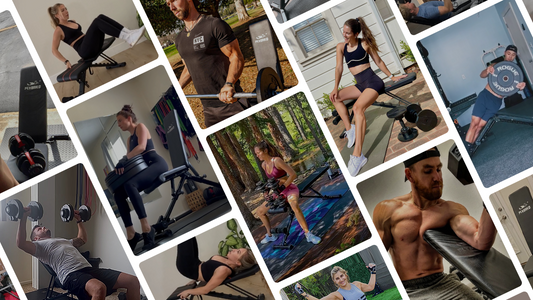A Roman chair is a compact weight bench made to be utilized in a way that works your upper legs, glutes, and back while using your body weight as resistance. They usually have several foam rollers and a tiny padded seat for you to rest on to support your weight and position while exercising.
Roman chairs are used in a certain way that also stretches the lower back muscles, which can be excellent for strengthening this area and reducing the risk of back issues.
In this article, we will discuss Roman chair muscles worked, and hyperextension muscles worked.
Roman Chair Muscles Worked.
What muscles does a roman chair work?
The Roman chair is the name given to many exercises. It is unclear what the movement's oldest or most common historical meaning was. All versions can be significantly resisted by body weight, and the difficulty can be raised by adding more weight.
When using a "Roman chair," the main movements are inhaling and exhaling. When inhaling, the lower neck should remain straight while the hips are bent forward, and the chest is lowered toward the floor.
To exhale, straighten the body and return to the starting posture for one repetition.
Roman chair hyperextension muscles worked offers a diverse range of strength training exercises that target all the body's major muscle groups, which are as follows:
Roman Chair Back Extension Muscles Worked.
The posterior trunk muscles, known as the lumbar extensors, are crucial for human movement and posture. From the perspective of spinal health, these muscles, which include the erector spinae, multifidi, and quadratus lumborum, are highly critical because they help give stability to an area of the spine that is vulnerable to damage.
Lower back discomfort has been related to deconditioning the lumbar extensor muscles. The lumbar extensors can be strengthened using a variety of workouts.
These muscles are used isometrically during compound movements like the squat, deadlift, and good morning, among others, since they stabilize the spine during exercise.
However, the activation of the lumbar muscles is permanently reduced during these exercises since the larger hip extensor musculature must dynamically carry the bulk of the load. As a result, they could not receive an appropriate stimulus for adaptation.
Therefore, The Roman chair is required to perform isolated dynamic lumbar extension exercises necessary to maximize the muscle's strength- and functional-related adaptations.
If performed with good technique and consideration for the needs and abilities of the individual, the Roman chair back extension is a safe and effective movement. Exercises are usually not "good" or "bad," but rather instruments to reach a specific goal.
When choosing exercises for program design, the fitness professional must consider all facets of the risk-reward continuum.
Key Points to Remember
- Your trunk should hang off the end while your hips and legs should be supported.
- You can cross your hands on your chest (the simplest position), behind your ears, or in front of your face (most challenging).
- When your head is almost touching the floor, lower your upper body. Then, lift your torso back up until your legs are straight.
- One of the few workouts where it's acceptable to round your lower back is this one (you can roll your back up and down like a snail).
However, you might not want to perform this exercise by rounding your lower back if you have lower back issues. Instead, bend your back as little as possible without rounding it, then straighten your body to the beginning position.
- Your torso should move in an approximately 90-degree arc up and down. Do not overextend your spine. The glutes and hamstrings produce hip extension while the erector muscles work to support and straighten the spine.
- If you want to focus your effort on the erector, you must carefully roll your spine up and down. To achieve this, you will have to do an exercise rather slowly.
Spinal flexion
Abdominal workouts are carried out in the Roman chair. An exerciser bends backward and lifts themselves with their rectus abdominis while stabilizing the pelvis with their hip flexors as they lie supine with their hips supported on the rear (weight on the gluteus maximus).
Hip flexors will also work as dynamic prime movers if the pelvis moves while doing the exercise.
Knee extension
The Roman chair is a variation of the exercise known more commonly as the wall sit, an isometric quadriceps strengthening exercise. It involves pressing against the wall with one's back to it while extending one's knees.
Even though it's called a "sit," the hips aren't supported by anything as you sit. Instead, the body is supported by friction made with the wall by pressing against it, together with the weight carried by the feet.
The "Roman chair squat" is another workout that demands dynamic quadriceps use. It also mimics sitting without really sitting down and can be performed using an apparatus, and is similar to the "sissy squat."
Wrap Up
By using a Roman Chair in your fitness routine, you can cut other workouts because it targets your back, abs, glutes, and upper legs all in one go. You'll either be able to work out faster or have more time to do other exercises.
Most Roman Chars are also adjustable, so if you're adding one to a shared home gym, you can change them as you progress for others to use. Despite their small size and intimidating appearance, they may have been among your best purchases.
We hope this article helped you with Roman chair muscles worked.
FAQs
When to Use a Roman Chair?
A roman chair is highly efficient for toning the abs and strengthening the back since it forces the upper part of the body to move and stabilize. This improves posture and reduces back pain.
With the help of a roman chair, you may perform back extensions that strain the muscles in your lower back and spinal erectors.
Does the Roman chair work your glutes?
Yes. A roman chair also strengthens the following muscles, though its main target is on the lower erector spinae: Hamstrings, gluteus maximus, hip adductors and neck extensors



